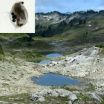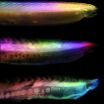(Press-News.org) SALT LAKE CITY—University of Utah (U of U) medical researchers have made an important step in diagnosing autism through using MRI, an advance that eventually could help health care providers indentify the problem much earlier in children and lead to improved treatment and outcomes for those with the disorder.
In a study published on October 15, 2010 in Cerebral Cortex online, researchers led by neuroradiologist Jeffery S. Anderson, M.D., Ph.D., U of U assistant professor of radiology, used MRI to identify areas where the left and right hemispheres of the brains of people with autism do not properly communicate with one another. Those areas are in "hot spots" associated with functions such as motor skills, attention, facial recognition, and social functioning— behaviors that are abnormal in autism. MRI's of people without the disorder did not show the same deficits.
"We know the two hemispheres must work together for many brain functions," says Anderson. "We used MRI to look at the strength of these connections from one side to the other in autism patients."
Other than increased brain size in young children with autism, there are no major structural differences between the brains of people with autism and those who do not have the disorder that can be used to diagnose autism on a routine brain MRI. It has been long believed that more profound differences could be discovered by studying how regions in the brain communicate with each other. The study, and other work U of U researchers are doing using diffusion tensor imaging (measures microstructure of white matter that connects brain regions), reveals important information about autism. The advances highlight MRI as a potential diagnostic tool, so patients could be screened objectively, quickly, and early on when interventions are most successful. The advances also show the power of MRI to help scientists better understand and potentially better treat autism at all ages.
"We still don't know precisely what's going on in the brain in autism," says Janet Lainhart, M.D., U of U associate professor of psychiatry and pediatrics and the study's principal investigator. "This work adds an important piece of information to the autism puzzle. It adds evidence of functional impairment in brain connectivity in autism and brings us a step closer to a better understanding of this disorder. When you understand it at a biological level, you can envision how the disorder develops, what are the factors that cause it, and how can we change it. "
An increasing number of studies have shown abnormalities in connectivity in autism, but this study is one of the first of its kind to characterize functional connectivity abnormalities in the entire brain using MRI rather than in a few specific pathways. The research involved about 80 autism patients between the ages of 10-35 and took about a year and a half to complete. The results will be added to an existing autism study following 100 patients over time. "The longitudinal imaging data and associated knowledge gathered forms a unique resource that doesn't exist anywhere else in the world," says Lainhart.
In addition to someday using MRI as a diagnostic tool for autism, researchers also hope to use the data to biologically describe different subtypes of autism. "This is a complex disorder that doesn't just fall into one category," says Lainhart. "We hope the information can lead us to characterizing different types of autism that may have different symptoms or prognoses that will allow us to identify the best treatment for each affected individual."
The collaborative autism imaging research group led by Lainhart is working together to develop methods to use brain imaging to better understand autism and improve the lives of affected individuals. It includes researchers in the departments of psychiatry, radiology, and pediatrics, the Neurosciences Program, the Scientific Computing and Imaging Institute, and The Brain Institute at the U of U, as well as collaborators at Brigham Young University, the University of Wisconsin, and Harvard University.
INFORMATION:
The University of Utah Health Sciences is internationally regarded for its research and clinical expertise in the health sciences. Through its four major colleges —the School of Medicine; College of Pharmacy; College of Nursing; and College of Health—the Health Sciences conducts leading-edge research in cancer, genetics, pharmaceutical sciences, and numerous other areas of medicine. The Health Sciences also is the major training ground of Utah's physicians, pharmacists, nurses, therapists, and other health-care professionals.
END
Some tiny crustaceans living in clear-water alpine ponds high in Washington state's Olympic Mountains have learned how to cope with the sun's damaging ultraviolet rays without sunblock – and with very little natural pigmentation to protect them.
In fact, in laboratory tests these water fleas, about the size of fruit flies, withstood UV rays much better than the same species of flea taken from a pond less than a mile away, where the water was murkier and thus offered protection.
"The ponds pretty much look the same to us, but the environments are very different for ...
PHILADELPHIA (October 12, 2010)—In an unexpected twist, Fox Chase Cancer Center researchers find that the loss of a single protein, Nedd9, initially slows cancer formation but then makes the tumors that do arise more aggressive. The good news, though, is that the lack of Nedd9 also makes the aggressive tumors more sensitive to a class of drugs that are already used in the clinic.
"If a tumor is able to overcome the loss of this protein, this clearly makes it undergo complicated changes that ultimately select for a more aggressive tumor," says Erica A. Golemis, Ph.D., ...
Researchers at the University of Edinburgh today report a new experimental compound that can improve memory and cognitive function in ageing mice. The compound is being investigated with a view to developing a drug that could slow the natural decline in memory associated with ageing.
With support from a Wellcome Trust Seeding Drug Discovery award, the team has identified a preclinical candidate that they hope to take into human trials within a year.
Many people find they become more forgetful as they get older and we generally accept it as a natural part of the ageing ...
The drug reboxetine is, overall, an ineffective and potentially harmful antidepressant, according to a comprehensive study of the evidence published on bmj.com today.
The study also shows that nearly three quarters of the data on patients who took part in trials of reboxetine were not published until now, and that the published data on the drug overestimate the benefits and underestimate the harms of treatment - all underlining the urgent need for mandatory publication of all clinical trial results.
Reboxetine has been approved for the treatment of major depressive ...
To assess the performance of general practices, it is better to ask patients about their actual experiences of care rather than ask for satisfaction ratings, according to new research published on bmj.com today.
The findings call into question the reliability of using surveys to evaluate practice performance.
Patient surveys are used to assess the performance of doctors and practices, and they increasingly enquire about specific patient experiences (e.g. waiting time for an appointment) as well as overall satisfaction.
In the UK, general practices receive some of ...
In a Canadian first, the Peter Munk Cardiac Centre used a new kind of left ventricular assist device (LVAD) to treat a patient with advanced heart failure. The new device is longer lasting than older generation LVADs and may eliminate the need for a second LVAD – a major drawback with the old technology.
The patient, 61-year-old Marva Lorde of Mississauga, suffered a heart attack in 2007 and underwent several treatments for heart failure – including a 10-day intensive care unit stay, angioplasty and pacemaker implantation –culminating in a cardiac arrest in June 2008.
"I ...
With Halloween and the holiday season fast approaching, many people will be watching their waistlines as they're tempted by a cornucopia of sugary and savory foods. Meanwhile a Georgia Tech College of Computing Ph.D. candidate has shown that playing health-related video games on a mobile device can help adults learn to live more healthfully by making smart diet choices. The finding is published in the paper, "Let's Play! Mobile Health Games for Adults," recently presented at Ubicomp 2010 in Copenhagen, Denmark.
OrderUP! is a different take on the recent trend of health-related ...
An innovative experiment at the University of Leicester that involved studying rotting fish has helped to create a clearer picture of what our early ancestors would have looked like.
The scientists wanted to examine the decaying process in order to understand the decomposition of soft-body parts in fish. This in turn will help them reconstruct an image of creatures that existed 500 million years ago.
Their findings have been published today, Wednesday 13th October, in the journal Proceedings of the Royal Society B. The work was funded by the Natural Environment Research ...
Eating steamed pears, having a soothing massage or bathing in a herbal mixture are just some of indigenous health practices used by older people to ward off or treat influenza, according to research published in the October issue of the Journal of Advanced Nursing.
Other traditional measures discovered by nurse researchers at the Hong Kong Polytechnic University included being rubbed with a coin, eating cheese, yoghurt and honey and having warm drinks made with ginger or lemon.
The team surveyed nine countries to find out why so many of them were failing to meet the ...
Winter canola might soon be the crop of choice for Pacific Northwest farmers, thanks to research by U.S. Department of Agriculture (USDA) scientists and their partners. The multitasking annual plant can be used to control weeds, supplement animal feed, produce biodiesel--and spark a new revenue stream for the Colville Confederated Tribes.
Frank Young, an agronomist with USDA's Agricultural Research Service (ARS), was part of a team that evaluated production protocols for winter canola in the Pacific Northwest. ARS is USDA's principal intramural scientific research agency. ...


